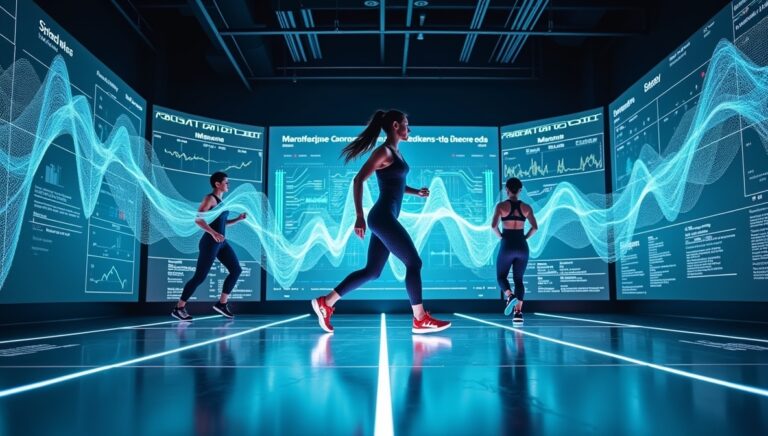In the rapidly evolving intersection of science, technology, and athleticism, a new concept is making waves — Sports Harmonicode. While the term might sound like a fusion of musical harmony and cryptographic coding, it actually represents a groundbreaking approach to optimizing human performance in sports using the combined power of artificial intelligence (AI), biomechanics, and physics.
As sports continue to push the limits of the human body, the need for precision training, injury prevention, and performance enhancement has never been more crucial. Sports Harmonicode aims to address these needs through a revolutionary methodology that is already redefining the way athletes train, coaches strategize, and fans experience competition.
What is Sports Harmonicode?
At its core, Sports Harmonicode is a multidisciplinary framework that decodes the harmonic patterns in athletic movement by leveraging AI algorithms, motion capture data, biomechanics, and principles of physics. Think of it as a digital fingerprint of an athlete’s performance — a real-time analytical model that interprets motion through the lens of harmonic balance, energy efficiency, and dynamic optimization.
The Science Behind the Harmonicode
To understand how Sports Harmonicode works, we must explore its three core pillars:
1. Biomechanics and Physics
Every athletic movement, from a sprinter’s stride to a gymnast’s flip, obeys the laws of physics. Biomechanics analyzes how the human body moves under the influence of forces. The Harmonicode captures these movements and interprets them as a series of harmonic oscillations — rhythmic, repeatable patterns that can be quantified, adjusted, and perfected.
For example, a tennis player’s serve can be broken down into angular velocities, torque generation, and energy transfer from foot to racquet. Through harmonic analysis, the code finds inefficiencies or deviations from optimal movement, allowing real-time corrections.
2. Artificial Intelligence and Machine Learning
AI brings intelligence and adaptability to the system. By feeding thousands of hours of athlete motion data into neural networks, the AI begins to learn what constitutes “harmonic motion” in various sports. Over time, it builds sport-specific, even athlete-specific, profiles that allow for customized recommendations.
Machine learning algorithms spot anomalies, predict potential injuries, and simulate ideal movement models. For instance, AI can suggest subtle changes in a footballer’s sprint posture to reduce ACL stress, or optimize a swimmer’s stroke for maximum hydrodynamic efficiency.
3. Human Physiology and Neural Coordination
The harmonic code isn’t just about muscles and mechanics — it’s about the brain too. Neural efficiency, proprioception, and muscle memory are all part of how humans move. The harmonicode model incorporates neurophysiological data, like EMG (electromyography), to understand how signals from the brain translate into motion.
Applications of Sports Harmonicode in Modern Athletics
1. Injury Prevention and Recovery
One of the biggest breakthroughs of Sports Harmonicode lies in its predictive power. By constantly monitoring harmonic patterns, the system can detect when an athlete’s motion becomes asymmetrical or biomechanically inefficient — early signs of fatigue or potential injury.
For rehabilitation, the harmonicode can guide recovery by comparing a recovering athlete’s current motion with their pre-injury harmonic profile, ensuring a safe and scientifically validated return to form.
2. Performance Optimization
Whether you’re a sprinter shaving off milliseconds or a golfer perfecting their swing, performance often hinges on small details. Sports Harmonicode offers precision diagnostics and personalized feedback that are far beyond what traditional coaching can offer.
The technology can simulate “ideal” movement patterns based on the athlete’s body type, strength levels, and sport-specific requirements. These simulations provide a clear roadmap for achieving peak performance.
3. Tactical Training and Strategy
In team sports like football, rugby, or basketball, the Harmonicode model can analyze group dynamics. By decoding movement harmony within a team — how players position themselves, how quickly they transition, or how synchronized their patterns are — coaches gain unprecedented insights into team coherence and tactical efficiency.
It’s like a new kind of playbook — one based not just on strategy, but on the actual harmonic balance of movement within the game.
Real-World Examples and Case Studies
– Track & Field
Elite runners are now using harmonicode-assisted training to fine-tune their stride length, foot strike angle, and energy return. This has led to improved times, fewer injuries, and better endurance.
– Football (Soccer)
Clubs in the Premier League and La Liga have begun experimenting with harmonicode-based training regimes. The technology has been used to rehabilitate star players faster and more effectively by comparing their motion pre- and post-injury.
– Martial Arts
In sports like Taekwondo and MMA, fighters use the Sports Harmonicode to enhance strike timing, improve balance during takedowns, and refine their defensive movement patterns.
Challenges and Limitations
As promising as Sports Harmonicode is, it is not without challenges:
- Data Collection Complexity: Accurately capturing motion in high detail requires advanced sensors, motion-capture suits, and consistent calibration.
- High Cost: At present, this technology is more accessible to elite athletes and institutions due to its expensive infrastructure.
- Human Variability: No two athletes are alike. Developing truly personalized harmonic profiles requires extensive data and adaptive AI, which can be time-consuming.
However, with the rise of wearable tech and cloud-based analytics, these barriers are rapidly being lowered.
The Future of Sports Harmonicode
The potential of Sports Harmonicode is vast. In the next decade, we could see:
- Mainstream Adoption: Affordable versions of harmonicode systems built into smart shoes, compression wear, or AR/VR training platforms.
- Integration into Youth Sports: Helping young athletes develop biomechanically safe and efficient habits early on.
- Fan Experience Evolution: Imagine live broadcasts offering real-time harmonic breakdowns of athletes — turning spectators into analysts.
Moreover, as AI grows more sophisticated and quantum computing enters the scene, the harmonicode’s predictive and prescriptive powers will only increase.
Final Thoughts
Sports Harmonicode is not just another tech trend — it represents a paradigm shift in how we understand and improve human performance. By decoding the complex symphony of movement into intelligible, actionable patterns, it empowers athletes, coaches, and even fans to engage with sports on a deeper level.
As the lines between man and machine, instinct and analysis, training and innovation continue to blur, one thing becomes clear: the future of sports is harmonic.


